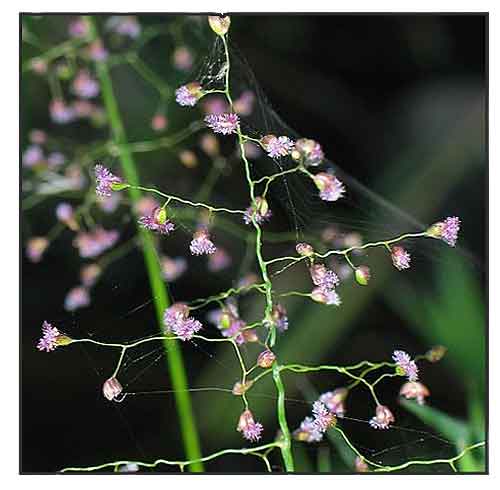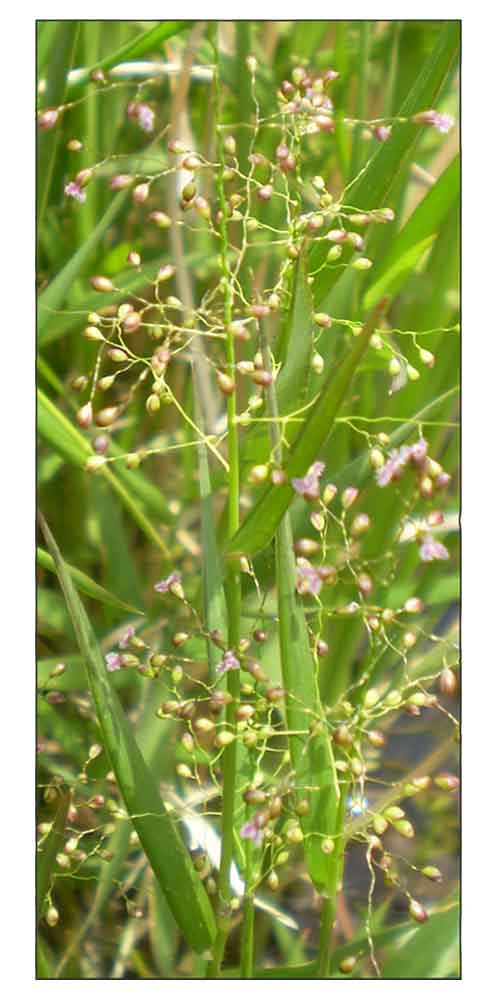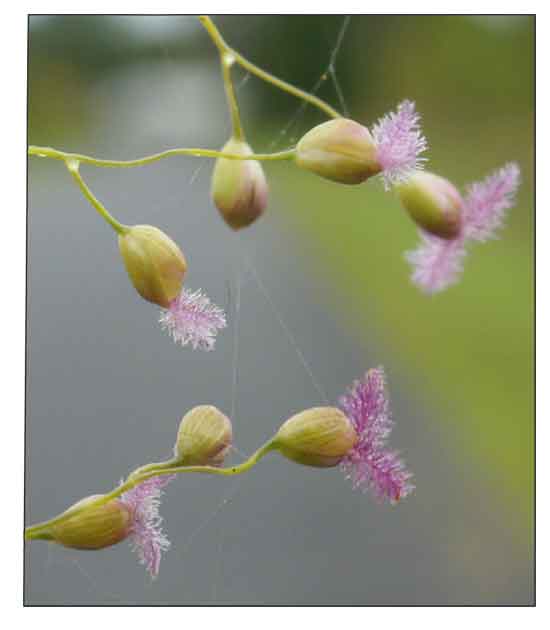
Family • Poaceae
Kawayan-kawayan
Isachne globosa Steud.
SWAMP MILLET / PURPLE BAMBOO
Liu ye ruo
| Scientific names | Common names |
| Agrostis globosa (Thunb.) Poir. | Kawayan-kawayan (Tag.) |
| Aira ischoemoides (Thunb.) J.Koenig ex Kunth | Kaway-kawayan (Tag.) |
| Aira violacea Willd. ex Steud. | Globose twinball grass (Engl.) |
| Eriochloa globosa (Thunb.) Kunth | Globose Zo-Sasa (Engl.) |
| Eriochloa japonica Steud. | Marsh millet (Engl.) |
| Helopus globosus (Thunb.) Steud. | Purple bamboo (Engl.) |
| Isachne adstans (Steud.) Miq. | Swamp millet (Engl.) |
| Isachne altissima Debeaux | |
| Isachne atrovirens (Trin.) Trin. | |
| Isachne australis R.Br. | |
| Isachne australis var. effusa Trin. ex Hook.f. | |
| Isachne dispar Trin. | |
| Isachne dispar var. villosa C.E.C.Fisch. | |
| Isachne globosa Steud. | |
| Isachne globosa var. brevispicula Ohwi | |
| Isachne globosa var. compacta W.Z.Fang ex S.L.Chen | |
| Isachne globosa var. davuymbuensis Jansen | |
| Isachne globosa var. effusa (Trin. ex Hook.f.) Senaratna | |
| Isachne globosa var. obscura (Buse) Henrard | |
| Isachne heterantha Hayata. | |
| Isachne javana Nees ex Miq. | |
| Isachne lepidota (Steud.) Walp. | |
| Isachne lutania Santos | |
| Isachne miliacea Roth | |
| Isachne miliacea var. obscura Buse | |
| Isachne miliacea var. stricta Ridl. | |
| Isachne muricata Nees ex Steud. | |
| Isachne nodibarbata (Hochst. ex Steud.) Henrard | |
| Isachne ponapensis Hosok. | |
| Isachne subglobosa Hatus. & T.Koyama | |
| Isachne virgata Nees ex Steud. | |
| Milium globosum Thunb. | |
| Panicum adstans Steud. | |
| Panicum antipodum Spreng. | |
| Panicum atrovirens Trin.. | |
| Panicum australe (R.Br.) Raspail | |
| Panicum batavicum Steud. | |
| Panicum benjamini Steud. | |
| Panicum dispar (Trin.) Steud. | |
| Panicum lepidotum Steud. | |
| Panicum nodibarbatum Hochst. ex Steud. | |
| Panicum violaceum Klein ex Thiele | |
| Isachne globosa is an accepted species. KEW: Plants of the World Online | |
| Other vernacular names |
| BANGLADESH: Jhirjhirighash. |
| BHUTAN: Sano banso, Sano ghode dubo. |
| CHINESE: Liu ye ruo. |
| INDIA: Chovverippullu, Naringa, Njammal, Changalipullu, Daura. |
| JAPANESE: Chigoxasa. |
| SRI-LANKA: Bata della (Sinhala), Bata dalla, Batadhalla. |
Distribution Properties Availability |
April 2025
![]()
 |
| PHOTOS / ILLUSTRATIONS |
| IMAGE SOURCE: Isachne globosa / Macleay Grass Man / CC BY 2.0 / Click on image or link to go to source page / Wikipedia |
| OTHER IMAGE SOURCE: Isachne globosa - Swamp millet / © Jackie Miles / Budawang Coast Nature Map / Non-commercial use / Click on image or link to go to source page / YarraRangesCouncil |
| OTHER IMAGE SOURCE: Isachne globosa - Swamp millet / Show_ryu / Public Domain / Wikipedia |
| OTHER IMAGE SOURCE: Upper fertile floret with purple stigmas at apex / Harry Rose / CC BY 2.0 / Image modified / Click on image or link to go to source page book / Wikimedia Commons |
Additional
Sources and Suggested Readings |
• |
DOI: It is not uncommon for links on studies/sources to change. Copying and pasting the information on the search window or using the DOI (if available) will often redirect to the new link page. (Citing and Using a (DOI) Digital Object Identifier) |
| List of Understudied Philippine Medicinal Plants |
| New plant names needed The compilation now numbers over 1,500 medicinal plants. While I believe there are hundreds more that can be added to the collection, they are becoming more difficult to find. If you have a plant to suggest for inclusion, native or introduced, please email the info: scientific name (most helpful), local plant name (if known), any known folkloric medicinal use, and, if possible, a photo. Your help will be greatly appreciated. |
• |
 |


 • Perennial. Culms slender to moderately robust, erect or decumbent and rooting at lower nodes, up to 80 cm tall, nodes glabrous, eglandular or with glandular ring. Leaf sheaths shorter than internodes, glabrous except for ciliate outer margin; leaf blades narrowly lanceolate, 3–10 × 0.4–0.8 cm, glabrous, scabrid, base rounded, apex acute; ligule 1–2 mm. Panicle open, ovate in outline, 4–11 cm, glandular, many-spiculate; branches and pedicels filiform, flexuose; pedicels variable in length, shorter or longer than spikelets. Spikelets elliptic-globose, 1.5–2(–2.2) mm, greenish or purplish brown; florets slightly to clearly dissimilar; lower floret male, upper floret female; glumes subequal, as long as or shorter than florets, broadly elliptic, 5–7(–9)-veined, usually glabrous, rarely hispidulous or scaberulous above middle, apex broadly rounded; lower lemma oblong, cartilaginous to subcrustaceous, shallowly convex, back sometimes sulcate, smooth, glabrous; anthers 0.8–1.3 mm; upper lemma crustaceous, shorter and more convex, slightly rough, back glabrous or puberulous, upper margins ciliate. (
• Perennial. Culms slender to moderately robust, erect or decumbent and rooting at lower nodes, up to 80 cm tall, nodes glabrous, eglandular or with glandular ring. Leaf sheaths shorter than internodes, glabrous except for ciliate outer margin; leaf blades narrowly lanceolate, 3–10 × 0.4–0.8 cm, glabrous, scabrid, base rounded, apex acute; ligule 1–2 mm. Panicle open, ovate in outline, 4–11 cm, glandular, many-spiculate; branches and pedicels filiform, flexuose; pedicels variable in length, shorter or longer than spikelets. Spikelets elliptic-globose, 1.5–2(–2.2) mm, greenish or purplish brown; florets slightly to clearly dissimilar; lower floret male, upper floret female; glumes subequal, as long as or shorter than florets, broadly elliptic, 5–7(–9)-veined, usually glabrous, rarely hispidulous or scaberulous above middle, apex broadly rounded; lower lemma oblong, cartilaginous to subcrustaceous, shallowly convex, back sometimes sulcate, smooth, glabrous; anthers 0.8–1.3 mm; upper lemma crustaceous, shorter and more convex, slightly rough, back glabrous or puberulous, upper margins ciliate. (

